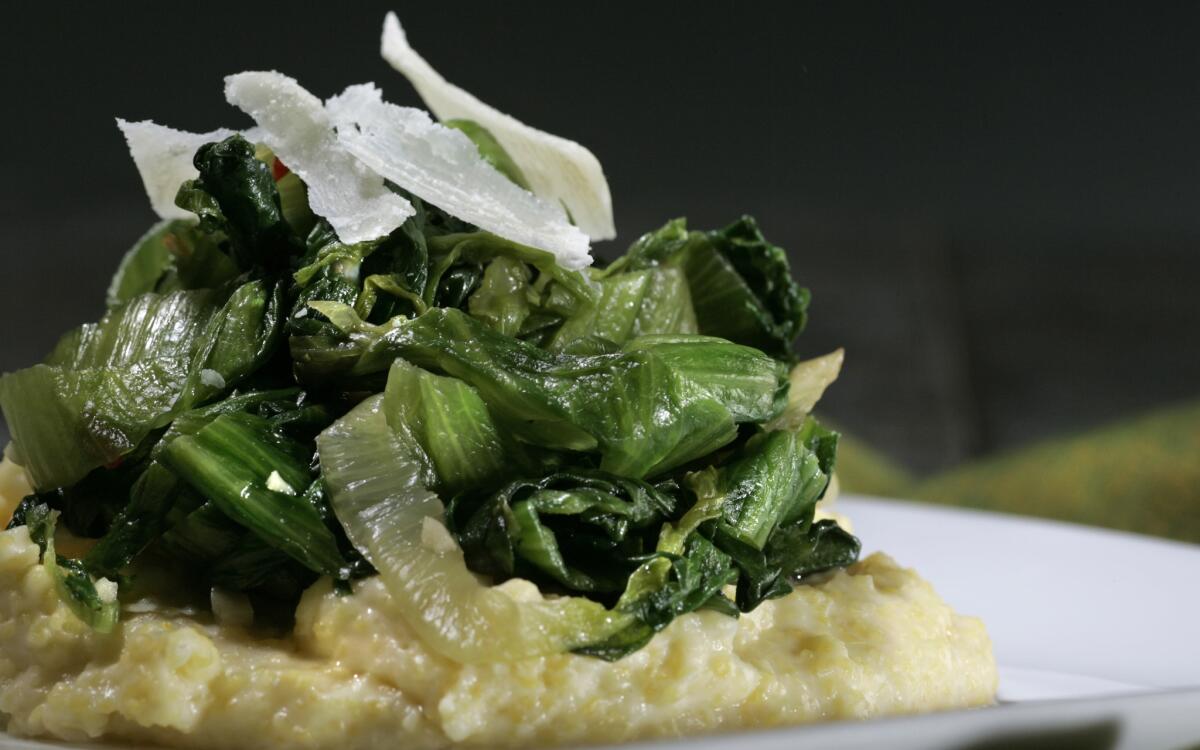Escarole with aged Parrano cheese and soft polenta

Look at the wildly tangled leaves of curly endive, the furiously jagged edges of dandelion greens, the deep furls of escarole and right off you know there’s something about them that’s just begging to be tamed.
It’s a bit of a paradox. These greens are loved for their bitter bite, but harnessing that bite -- say, by adding the spice of chiles or the sweetness of bacon or by giving them a quick blanch or even just a saute -- is what makes them sing.
And at this time of year, bitter greens are calling from nearly every other stall or stand at the farmers market or the grocery store; they’re a boon of winter. Until fairly recently, bitter greens have been popular in this country only in the South, but more of them have become more widely available, though their names still can be confusing. Greens in the chicory and endive family include Belgian endive (also called French endive and witloof), curly endive (sometimes called chicory or frisee), escarole and several varieties of radicchio. Then there are dandelion greens, mustard greens and turnip greens (yes, keep the tops of your turnips).
Maybe our bent for bitter greens started with the exploding popularity of rapini -- or broccoli rabe -- a green brought to the U.S. by Italian immigrants. Its deep, complex flavor has everything to do with its bitterness, and it’s wonderful punctuated by a shower of Parmesan, a dash of bottarga (dried mullet roe) or a dose of spicy sausage.
Cooking, whether a slow simmer or quick saute, is the first step in taming bitter greens. Heartier varieties such as turnip greens require a longer cook time to reduce their bite and soften their texture. Tender leaves such as frisee can be mellowed with just a quick toss in a warm vinaigrette, though their bitterness is so gentle that you can also serve them untamed.
Traditional recipes might insist that greens be cooked a minimum of an hour, or require long preblanching times for even delicate greens such as escarole. These methods do remove much of the bitterness of greens, but they also remove a lot of their color and texture.
Unless you like your greens on the soft side, reserve blanching and braising for very sturdy greens such as rapini. It can take a slightly longer cook time than more delicate greens, and blanched rapini is noticeably less bitter after cooking than when it is added to the pan raw.
Whether cooked to softness or barely wilted, bitter greens benefit greatly from three simple additions: salt, fat and spice.
Salt takes the edge off bitterness in any food, and that’s especially true with bitter greens. And these have the backbone to stand up to salt in some of its most potent forms. In southern Italy, cooks often use anchovies to season and add depth to simple dishes such as braised escarole or dandelion greens (whatever’s in season) with garlic and olive oil. Or you can go the Asian route: Soy sauce, with its slightly sweet, rich flavor, rounds and balances the flavor of mustard greens or turnip greens too.
Fat is the great equalizer; it not only softens harsh tastes, it also brings flavors together on the palate. It doesn’t take much -- a little olive oil is enough to meld the assertive flavors of garlic, chile and escarole and make them all work perfectly together. Add a little more richness in the form of soft polenta made with a bit of cream and grated Fontina or Parrano cheese, a pale yellow cow’s milk cheese from Holland, and you have an ideal base for simple sauteed greens. And then there’s sausage -- rapini with Italian sausage is a no-brainer. Pair rapini with linguica and roasted potatoes, though, and you get a Portuguese take on the Italian green, inspired by a traditional dish called caldo verde. The linguica is mild and smoky and unctuous, and the fattiness of the meat brings out the texture and flavor of the rapini.
Turnip greens are too often overlooked, tragically tossed aside. But they’re the stand-out in a Caribbean-style soup made with crab, bacalao (salt cod), creamy coconut milk and chiles. The salt cod, coconut and peppers provide an intriguing base in this soup, but the turnip greens make the dish. Traditionally, callaloo soup is made with callaloo leaves or spinach, but the turnip greens are as tender and delicious, and it’s their edge of bitterness that sets this soup apart.
Wash the escarole leaves in two changes of water. Trim the stems. Set aside the very tender yellow-green core, reserving for salads. Dry and cut the leaves into strips about one-half inch wide.
In a heavy saucepan, combine the stock and cream and bring the mixture to a boil. Add three-fourths teaspoon salt, then whisk in the polenta. Cook over low heat, stirring constantly with a wooden spoon, for 20 to 30 minutes, until the polenta is thick, soft and creamy. Stir in the Parrano cheese.
In a large saute pan, heat the olive oil over medium heat. Add the garlic and saute until soft, about 2 minutes. Stir in the red pepper. Add the escarole. You may need to allow half the escarole to wilt in the pan before adding the rest. When the leaves have begun to wilt, stir them carefully so that they become evenly mixed with the sauteed garlic. The greens are done when they are tender and wilted, about 10 minutes. Season to taste with salt. Serve the escarole on top of the polenta. Garnish with shaved Parmesan.
Get our Cooking newsletter.
Your roundup of inspiring recipes and kitchen tricks.
You may occasionally receive promotional content from the Los Angeles Times.















